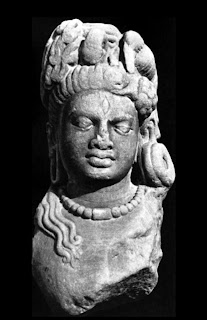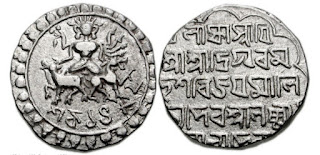Ardhanarishvara is a composite form of the Hindu deities Shiva and Parvati and is depicted as half-male and half-female, equally split down the middle. The conception of Ardhanarishvara has been described in Vedic and Upanishad literature. It reflects a concept of dualism, something similar to the Chinese philosophy of Ying - Yang where contrary forms masculine and feminine are actually complimentary of each other, interconnected and interdependent, a perfect state of neutrality and equilibrium.
The left portion of the body is associated with the heart and is related to feminine characteristics, intuition and creativity, while the right portion reflects masculine traits of logic, valour and thought process.
Chola Bronze from the 11th century
Ardhanarishvara is also known by other names like Ardhanari (the half manwoman), Ardhanarisha, Narnari, Ammiappan (in Tamil meaning Mother-Father) and Ardhayuvatishvara (in Assam, meaning "the lord whose half is a young woman or girl).
The earliest images and concept of Ardhanarishvara originated in Kushan (30-375 AD) and Greek cultures (referred by Greek author Bardasanes around 154-222 AD) simultaneously but was perfected in the Gupta era (320-600 AD). It is also interpreted as an attempt to syncretize the two principal Hindu sects, Shaivism and Shaktism, dedicated to Shiva and the Great Goddess. Some coins of the Kushan era probably carried the image but they are quite defaced and hence the iconography over them is disputable.
Ardhanarishavara relief from Elephanta Caves, near Mumbai
Ardhanarishvara sculpture, Khajuraho
Ardhanarishvara, 6th century, Jhalawar museum, Rajasthan
Many nations of southeast Asia have unearthed sculpture of Ardhanarishvara including Sri Lanka.
Coinage of Tripura. Though Rana Manikya was the first to strike coins and in the rule for three decades issued numerous coins, the most unique of the depiction of deities on Tripura coins is the Ardhanarishvara. The royal lineages of Manikya dynasty were the followers of Shaivite beliefs, and it was beautifully illustrated on their coinage.
Tripura, Vijaya Manikya, 1532-1564, tanka, weight 10.65 gm, figure of Ardhanarishvara, with Durga on her lion and Shiva on bull, 5-line legend within 12 arc scallops, star below the "sh"of mahesh in the third line
Tripura, Vijaya Manikya, 1532-1564 AD, Tanka, weight 10.61 gm, figure of Ardhanarishvara, composed of Durga on her lion and Shiva on his bull, 5-line legend within 12 arcs scallop, double struck.













Was unaware that the powerful concept of gender equality symbolized by the depiction of the Supreme Being as Ardh Nareeshwara had been minted on coins. Inspires one to read about the dynasties linked to the statues and coins.
ReplyDeleteWhat an incredible collection witha wealth of knowledge and history.Effort of generations, put together painstakingly.Wow
ReplyDeleteWhat an incredible collection witha wealth of knowledge and history.Effort of generations, put together painstakingly.Wow
ReplyDeleteWhat an incredible collection witha wealth of knowledge and history.Effort of generations, put together painstakingly.Wow
ReplyDeleteThe concept of gender equality or the balance of masculine n feminine energies has been part of not just indian historical culture but also others. The fact that it was minted on coins it must have been prevelant then. Very interesting blog General Sharma. Look forward to more . Do appreciate your painstaking research.
ReplyDeleteRegards
Alpana
Wow...amazing facts
ReplyDeleteThis particular papers fabulous, and My spouse and i enjoy each of the perform that you have placed into this. I’m sure that you will be making a really useful place. I has been additionally pleased. Good perform! semi precious stone dice
ReplyDelete